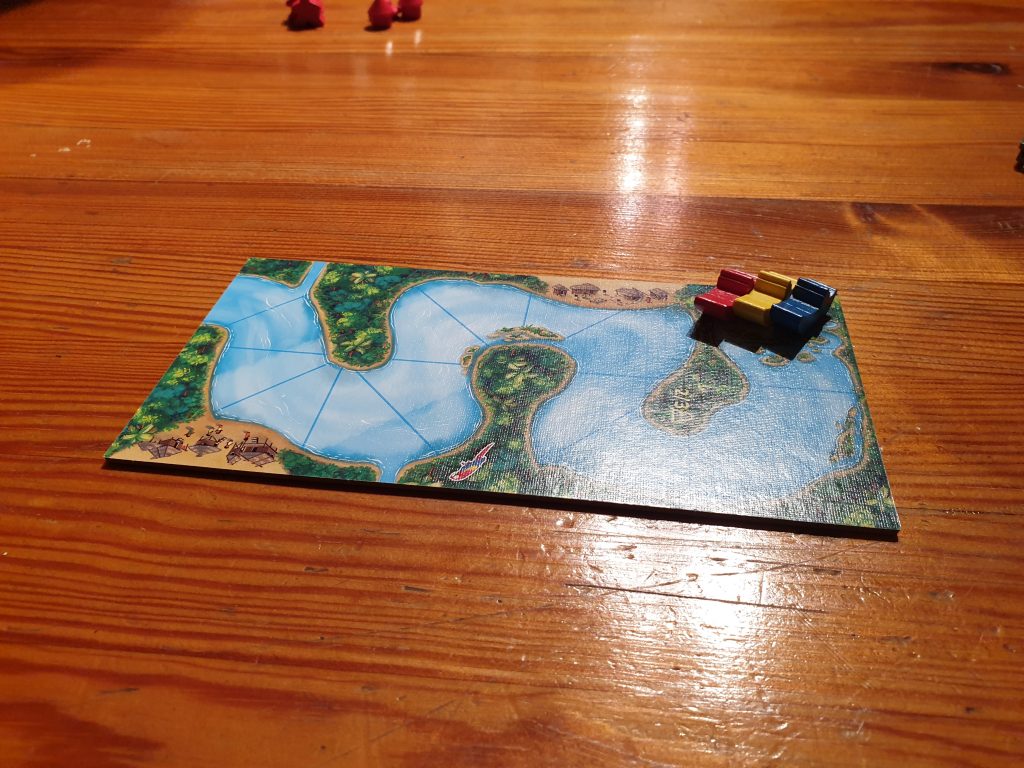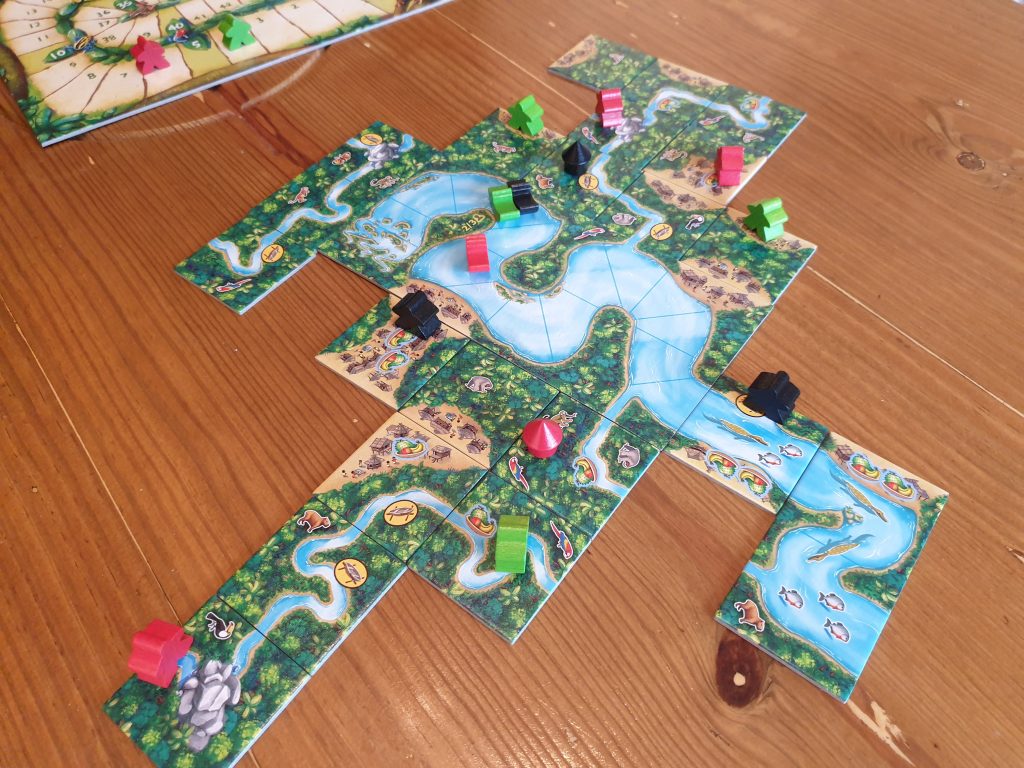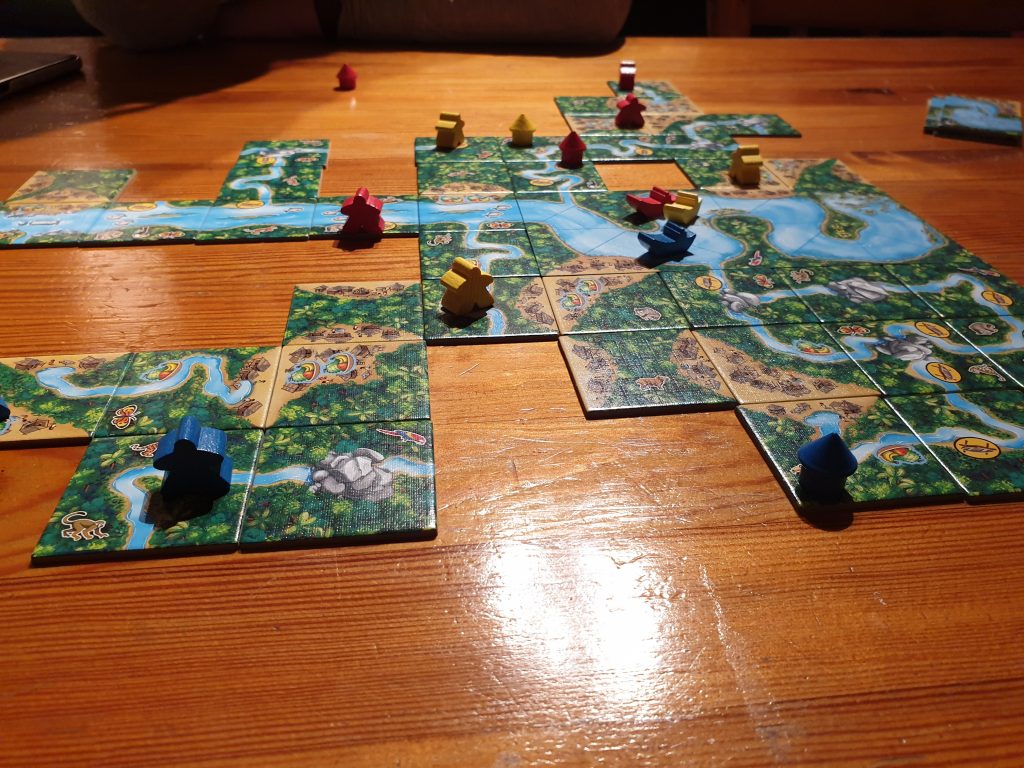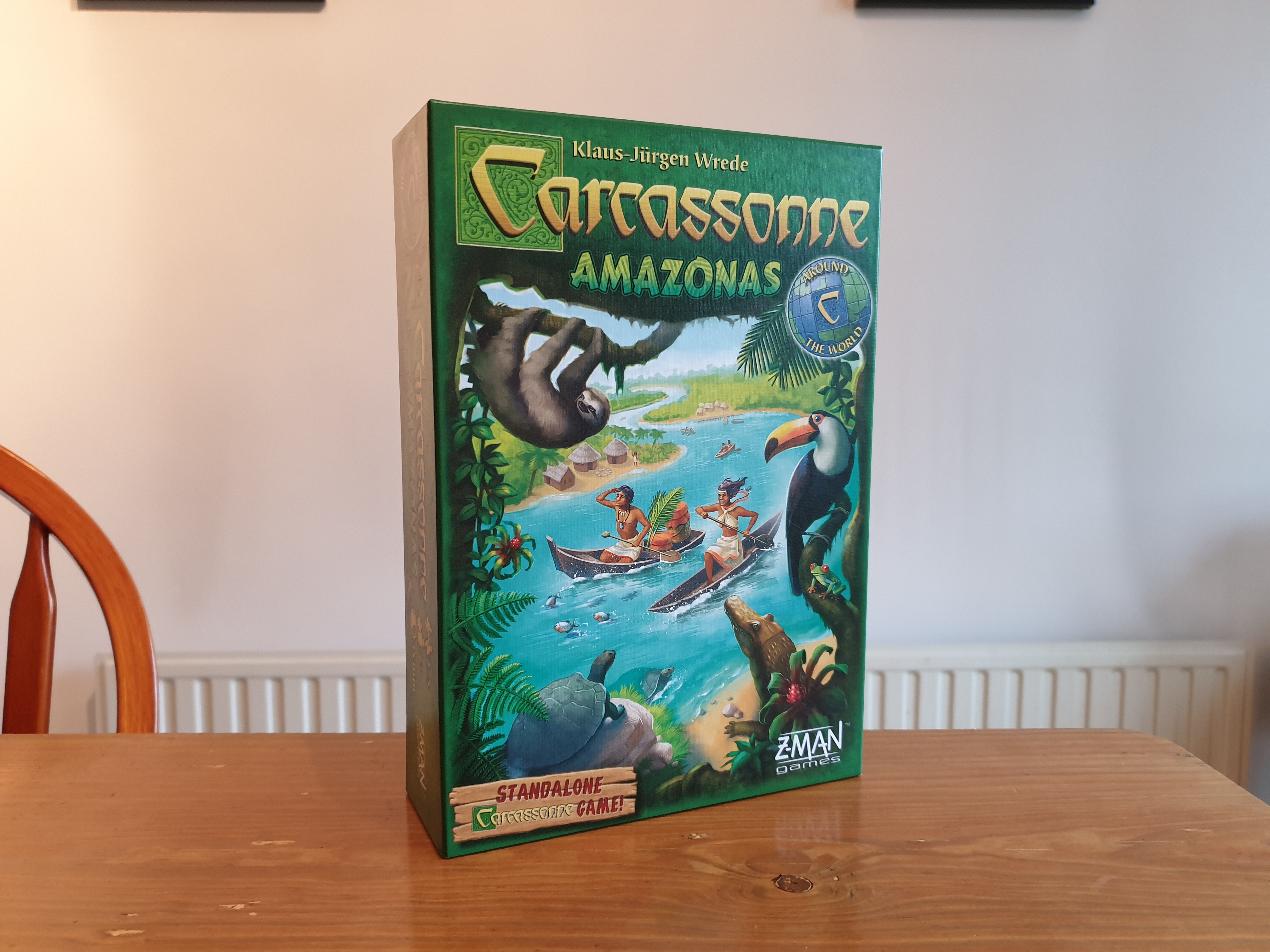Carcassonne Amazonas, the 2016 release in the Around the World series from Hans im Glück and Z-Man Games, is a tile placement board game. Designed by Klaus-Jürgen Wrede, with art from Vicki Dalton, the game sees 2 – 5 players swap the French countryside town of Carcassonne for the thick Amazon jungle and its iconic river. However, is the trip to a new location worthwhile? Let’s find out!
Note: This review will focus on the changes the Amazonas variant brings in. If you are new to the Carcassonne series check out our reviews of the other variants: the original Carcassonne, Gold Rush and Safari.
With the new theme a thick jungle replaces the green fields, roads become tributaries, cities become native villages and monasteries didn’t make the cut. The new addition to the game is the Amazon river itself, which players are racing down. This is not like the mini-expansion for the base game The River, though it does see the game start with a 2×4 board instead of a single tile.

So, how do players race down the iconic river? During play, after placing a tile, if the player decides not to place a meeple or hut they move their boat one step down the river. A selection of the tributaries tiles also feature boat symbols and when added to a claimed tributary also trigger the players boat moving a step down the river. This means it is entirely possible for a players boat to move multiple times on one turn.
When river tiles are drawn from the draw pile and put into play a scoring event is initiated. Firstly, if the tile features a ! symbol, nicely disguised on the tile as rocks in the river, a special double river tile is added to the board at the end of the river. Then, whomever is in first place in the river race – including joint first – scores points equal to the number of piranhas and crocodiles featured on the newly placed tile. Second place then scores points equal to only the amount of piranhas on the tile. Anyone behind second then moves 1 space along the river – an obvious but balancing catch up mechanic.
Having only 4 meeples to play with, with a 5th on the score tracker, means gamers will have to choose the optimal times to jump onto features. Thankfully, given the limited meeple count, the farmer rules that earn points from fields in the base game are not included. Replacing them are huts. Each player starts with two huts, which can be placed on a turn instead of a meeple onto the jungle area of the placed tile. These, like farmers, once placed cannot be moved. Huts score a point per animal depicted in the jungle area they occupy at the end of the game. This means they can score a huge amount of points, with tributaries, native villages and the river splitting jungle areas.

One minor change is that shields, originally found only in cities, are now fruit baskets. In Carcassonne Amazonas baskets are found floating in tributaries and in native villages alike. Akin to shields they score an additional point when scoring a feature, be it during the game when a feature is complete or at the end of the game.
Monasteries are one of my favourite scoring opportunities in the base game, so not including them seemed a shame. Once playing though it is obvious to see why, with a great balance between all of the scoring methods. The tiles that feature the Amazon river, despite being mechanically different, are what has replaced the tiles that would feature monasteries. The annoyance with these exacerbates the issue that you are forced to place the tile you’ve picked up. If far behind in the river race drawing these river tiles and seeing your opponents pull away on the score tracker on your turns is more painful than when done by them.
The river race doesn’t just score points during the game. At the end of the game the boats are put on a podium like tile to assign bonus points for getting furthest down the river. This is a small bump of points, with only 6 points going to the winner. Therefore, it doesn’t drastically change the outcome of most games with scores often over 100 points.
One aspect of the Carcassonne franchise that always captivated me was the way the board dynamically grows across the table. In this variant the Amazon river and its tributaries carve themselves across the table but the rest of the board doesn’t always keep up. Due to a tile placement limitation of never building in past the current river tile the board often darts of in other directions. Then, when a new river piece is added players are already invested in tributaries and native villages, looking to build those out rather than building alongside the new river tile. While later on new sections are built off the river there are always numerous river tiles at the end of the game with nothing adjacent to them – giving somewhat of an incomplete map look to the board.

With fruit baskets a tad more prevalent than shields and the additional boat symbols for movement on tiles, the board is busier than other variants. This is perhaps exaggerated by the jungle design with animals that pop from it scattered about. The board isn’t unreadable but for a quick glance it isn’t as intuitive to read. Combine this with the additional race that is going on and it can take players new to the series a tad longer to read the board and make decisions. Anyone that has played another variant, or had a game under their belt of Amazonas, was able to keep up the speed. It doesn’t turn the game into a drag but it can extend the game by a good 10 minutes, something to be conscience of.
Production wise Carcassonne Amazonas sits proudly alongside the other variants. The tiles are of the same, decent, thickness – allowing them to shuffle nicely and be durable. The wooden components, meeples, boats and huts, are strong. Each has a distinct silhouette making them recognisable and their colours make them pop from the board. The copy I received has a broken red meeple, effectively missing legs. Despite never seeing this before I would assume it is a 1 in a million problem and not a component issue that plagues this game in particular. Plus, this piece can just used for the score tracker rather than regular play and placement.
The problem each Carcassonne Around The World variant has is it is going up against the original. The original for many has already entertained them for countless hours, plus it comes with the option of expansions. Setting all of that aside, Amazonas is an interesting twist. While the board doesn’t quite grow in the same captivating way, the game still captures the core lighthearted tile placement gameplay. Still, the race is an element that can result in a lot of points earnt – making it a real choice to not place meeples or huts down, even on good tiles, to get the boat movements. The river adds something which cannot be ignored, something which some will love and turn others away from the experience. As a result, this is a variant to try before you buy.
[Editor’s Note: Carcassonne Amazonas was provided to us by Asmodee for review purposes. The game is currently available from local board game stores, find your local store here]

